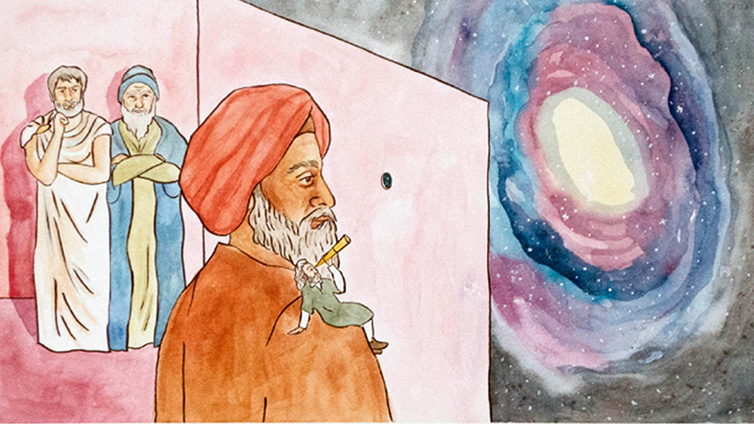Stars Form
Driving Question: Why is the formation of stars important?
The early Universe was very dark for its first 200 million years, but then something changed, and new complexity arose. Learn how the first stars formed and how their lives—and deaths—created the ingredients for the next threshold.
Learning Objectives:
- Describe star formation.
- Explain how stars created new complexity in the Universe.
Vocab Terms:
- atom
- complexity
- gravity
- proton
- star
- temperature
Opener: Stars Form
To teach this lesson step, refer to page 2 of the Lesson 2.3 Teaching Guide.
Our Openers and Closers Guide will provide more information about these short, but important activities at the beginning and end of each lesson.
It’s time to see how much you know—or think you know—about stars. Test your knowledge of how stars begin and end.
Stars Light Up
To teach this lesson step, refer to page 3 of the Lesson 2.3 Teaching Guide.
Check out the OER Project Video Guide to help you incorporate best practices when using video as part of your teaching.
When the Universe first lit up, it crossed the second Big History Threshold. What were the “Goldilocks Conditions” that allowed this to happen?
Star Formation
To teach this lesson step, refer to page 4 of the Lesson 2.3 Teaching Guide.
Learn more about how OER Project approaches teaching causation in this one page guide.
How did tiny atoms come together to light up the Universe? Find the answer to that question and more in this video, slideshow, and activity.
-
Guiding Questions
-
Before you watch
Preview the questions below, and then review the transcript.
While you watch
Look for answers to these questions:
- What were the “Dark Ages” of the Universe?
- What were the Goldilocks Conditions for star formation?
- What happens at 10 million degrees Celsius?
- What is a galaxy?
- What other structures can gravity pull together?
After you watch
Respond to this question: Do you think new stars are forming in the Universe today? Explain your reasoning.
Key Ideas
How Stars Form
What Are Stars Made Of?
To teach this lesson step, refer to page 6 of the Lesson 2.3 Teaching Guide.
Check out this tool to help support students while reading graphic biographies.
As recently as 100 years ago, scientists didn’t know what stars were made of. One graduate student changed that by using her intuition—and examining the evidence.
-
Guiding Questions
-
Before you read
Preview the questions below, and then skim the comic, paying attention to things like prominent colors, shapes, and types of text and fonts. How do you know where to start and in which direction to read? What’s in the gutters (the space between panels)? Who or what is the focus of the comic?
While you read
Look for answers to these questions:
- What does the graphic biography tell you about Cecilia Payne-Gaposchkin’s early life?
- What obstacles did Dr. Payne-Gaposchkin face when she decided to become an astronomer?
- What was Dr. Payne-Gaposchkin’s greatest discovery?
- How do the claim testers (authority, logic, evidence, and intuition) impact this scientist’s story?
- How does the page’s design, text, and illustrations contribute to your understanding of this scientist’s story?
After you read
Respond to this question: How does Dr. Payne-Gaposchkin’s story support, extend, or challenge what you’ve learned about claim testing so far in this course?
Who Is an Authority?
To teach this lesson step, refer to page 7 of the Lesson 2.3 Teaching Guide.
For more information about claim testing, take a look at this one page guide.
It’s never a bad idea to turn to an authority when you have a question. In this activity and article, you’ll do some thinking on who actually is an authority on star formation.
-
Guiding Questions
-
Before you read
Preview the questions below, and then skim the article. Be sure to look at the section headings and any images.
While you read
- What is the science of optics?
- What contributions did al-Haytham make?
- How did al-Haytham make his discoveries about how light worked?
- Why did Ibn al-Haytham encourage people to question all theories?
After you read
Respond to this question: How does al-Haytham’s story support, extend, or challenge what you’ve learned about the authority claim tester?
Closer: Stars Form
To teach this lesson step, refer to page 9 of the Lesson 2.3 Teaching Guide.
Take a look at some amazing student examples of star comics by joining this conversation in the OER Project teacher community.
How would you draw star formation in comic form? Use pictures and words to illustrate your star comic.
Mysteries of the Universe’s Origins
There are lots of questions we still have about the early Universe. And there are some questions that have been answered in recent years. Grab your headphones and some drawing materials for this audio and activity set.





















